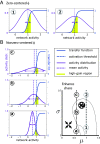Multitasking via baseline control in recurrent neural networks
- PMID: 37549275
- PMCID: PMC10437433
- DOI: 10.1073/pnas.2304394120
Multitasking via baseline control in recurrent neural networks
Abstract
Changes in behavioral state, such as arousal and movements, strongly affect neural activity in sensory areas, and can be modeled as long-range projections regulating the mean and variance of baseline input currents. What are the computational benefits of these baseline modulations? We investigate this question within a brain-inspired framework for reservoir computing, where we vary the quenched baseline inputs to a recurrent neural network with random couplings. We found that baseline modulations control the dynamical phase of the reservoir network, unlocking a vast repertoire of network phases. We uncovered a number of bistable phases exhibiting the simultaneous coexistence of fixed points and chaos, of two fixed points, and of weak and strong chaos. We identified several phenomena, including noise-driven enhancement of chaos and ergodicity breaking; neural hysteresis, whereby transitions across a phase boundary retain the memory of the preceding phase. In each bistable phase, the reservoir performs a different binary decision-making task. Fast switching between different tasks can be controlled by adjusting the baseline input mean and variance. Moreover, we found that the reservoir network achieves optimal memory performance at any first-order phase boundary. In summary, baseline control enables multitasking without any optimization of the network couplings, opening directions for brain-inspired artificial intelligence and providing an interpretation for the ubiquitously observed behavioral modulations of cortical activity.
Keywords: decision-making; mean field theory; multitasking; recurrent neural networks; reservoir computing.
Conflict of interest statement
The authors declare no competing interest.
Figures






Similar articles
-
The deep arbitrary polynomial chaos neural network or how Deep Artificial Neural Networks could benefit from data-driven homogeneous chaos theory.Neural Netw. 2023 Sep;166:85-104. doi: 10.1016/j.neunet.2023.06.036. Epub 2023 Jul 10. Neural Netw. 2023. PMID: 37480771
-
Chaotic recurrent neural networks for brain modelling: A review.Neural Netw. 2025 Apr;184:107079. doi: 10.1016/j.neunet.2024.107079. Epub 2024 Dec 27. Neural Netw. 2025. PMID: 39756119 Review.
-
Physical reservoir computing on a soft bio-inspired swimmer.Neural Netw. 2025 Jan;181:106766. doi: 10.1016/j.neunet.2024.106766. Epub 2024 Sep 26. Neural Netw. 2025. PMID: 39357267
-
Beneficial Perturbation Network for Designing General Adaptive Artificial Intelligence Systems.IEEE Trans Neural Netw Learn Syst. 2022 Aug;33(8):3778-3791. doi: 10.1109/TNNLS.2021.3054423. Epub 2022 Aug 3. IEEE Trans Neural Netw Learn Syst. 2022. PMID: 33596177
-
Recent advances in physical reservoir computing: A review.Neural Netw. 2019 Jul;115:100-123. doi: 10.1016/j.neunet.2019.03.005. Epub 2019 Mar 20. Neural Netw. 2019. PMID: 30981085 Review.
Cited by
-
Neural heterogeneity controls computations in spiking neural networks.Proc Natl Acad Sci U S A. 2024 Jan 16;121(3):e2311885121. doi: 10.1073/pnas.2311885121. Epub 2024 Jan 10. Proc Natl Acad Sci U S A. 2024. PMID: 38198531 Free PMC article.
References
-
- Stringer C., et al. , Spontaneous behaviors drive multidimensional, brain-wide population activity. bioRxiv [Prerpint] (2018). 10.1101/306019 (Accessed 4 January 2023). - DOI
Publication types
MeSH terms
Grants and funding
LinkOut - more resources
Full Text Sources

